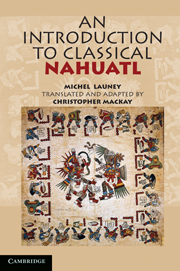Book contents
- Frontmatter
- Contents
- Preface
- How to Use This Book
- PART ONE
- PART TWO
- Lesson Sixteen Agent Nouns, the -ni Form
- Lesson Seventeen Compound Nouns, Verbal Incorporation
- Lesson Eighteen Bitransitive Verbs, Ambitransitive Verbs
- Lesson Nineteen Causative Verbs
- Lesson Twenty Applicative Verbs
- Lesson Twenty-One Honorific and Deprecatory Verbs
- Lesson Twenty-Two Pluperfect, Counterfactual, Vetitive, Directional Conjugations
- Lesson Twenty-Three Morphological Peculiarities of Certain Nouns and Verbs
- Lesson Twenty-Four More on Locatives
- Lesson Twenty-Five More on Quantifiers
- Lesson Twenty-Six Details about Number and Person, Indefinite Pronouns and Adverbs
- Lesson Twenty-Seven Compound Verbs
- Lesson Twenty-Eight Reduplication outside of the Plural, More on Verbs
- Lesson Twenty-Nine Derivative Verbs
- Lesson Thirty Derivative Nouns
- Lesson Thirty-One Noun Clauses
- Lesson Thirty-Two Attributives, Relative Clauses, Copula Verbs, Semi-Auxiliaries
- Lesson Thirty-Three Comparisons, Clauses of Result, Purpose and Cause
- Lesson Thirty-Four Conditions, More Particles
- Lesson Thirty-Five Temporal Clauses, Particles, Interjections
- Appendix One Traditional Orthography
- Appendix Two The Aztec Calendar
- Appendix Three Inflexional Patterns
- Appendix Four Key to the Exercises
- Nahuatl-to-English Vocabulary
- English-to-Nahuatl Vocabulary
- Index
Lesson Twenty-Five - More on Quantifiers
Published online by Cambridge University Press: 05 June 2012
- Frontmatter
- Contents
- Preface
- How to Use This Book
- PART ONE
- PART TWO
- Lesson Sixteen Agent Nouns, the -ni Form
- Lesson Seventeen Compound Nouns, Verbal Incorporation
- Lesson Eighteen Bitransitive Verbs, Ambitransitive Verbs
- Lesson Nineteen Causative Verbs
- Lesson Twenty Applicative Verbs
- Lesson Twenty-One Honorific and Deprecatory Verbs
- Lesson Twenty-Two Pluperfect, Counterfactual, Vetitive, Directional Conjugations
- Lesson Twenty-Three Morphological Peculiarities of Certain Nouns and Verbs
- Lesson Twenty-Four More on Locatives
- Lesson Twenty-Five More on Quantifiers
- Lesson Twenty-Six Details about Number and Person, Indefinite Pronouns and Adverbs
- Lesson Twenty-Seven Compound Verbs
- Lesson Twenty-Eight Reduplication outside of the Plural, More on Verbs
- Lesson Twenty-Nine Derivative Verbs
- Lesson Thirty Derivative Nouns
- Lesson Thirty-One Noun Clauses
- Lesson Thirty-Two Attributives, Relative Clauses, Copula Verbs, Semi-Auxiliaries
- Lesson Thirty-Three Comparisons, Clauses of Result, Purpose and Cause
- Lesson Thirty-Four Conditions, More Particles
- Lesson Thirty-Five Temporal Clauses, Particles, Interjections
- Appendix One Traditional Orthography
- Appendix Two The Aztec Calendar
- Appendix Three Inflexional Patterns
- Appendix Four Key to the Exercises
- Nahuatl-to-English Vocabulary
- English-to-Nahuatl Vocabulary
- Index
Summary
Quēxquich
In English, we distinguish countable (also called aggregate) nouns like ‘dogs’ or ‘bottles’ from non-countable nouns like ‘milk’ or ‘help’ in terms of how we speak of counting such entities. Sometimes we use different quantifier for the two categories. For instance, ‘many’ and ‘fewer’ are used of countable nouns, whereas the same notions are given for non-countable nouns in the form ‘much’ and ‘less’. When we inquire about the quantity of nouns, we use interrogative quantifiers, and here again there are different expressions for the two categories. For countable nouns, we say, ‘How many?’, even if the answer is not expected to take the form of a specific number (i.e., we expect the answer ‘a few’ or ‘not many’ rather than ‘five’). With non-countable nouns, we ask, ‘How much?’, and generally the answer has to be given in a non-numeric form (e.g., ‘a lot’, ‘not much’).
Nahuatl also has two different interrogative quantifiers, but the distinction between the two words is made on a different basis than in English. Whereas English concentrates on the nature of the noun (whether or not it can be counted), the two Nahuatl interrogatives are distinguished by the nature of the answer expected. We have already encountered quēzqui (7.1), which expects a specific answer in the form of a number. In addition, there's the interrogative quēxquich, which expects a non-specific answer like miyac ‘much/many’ or huēyi ‘big’.
- Type
- Chapter
- Information
- An Introduction to Classical Nahuatl , pp. 253 - 263Publisher: Cambridge University PressPrint publication year: 2011



